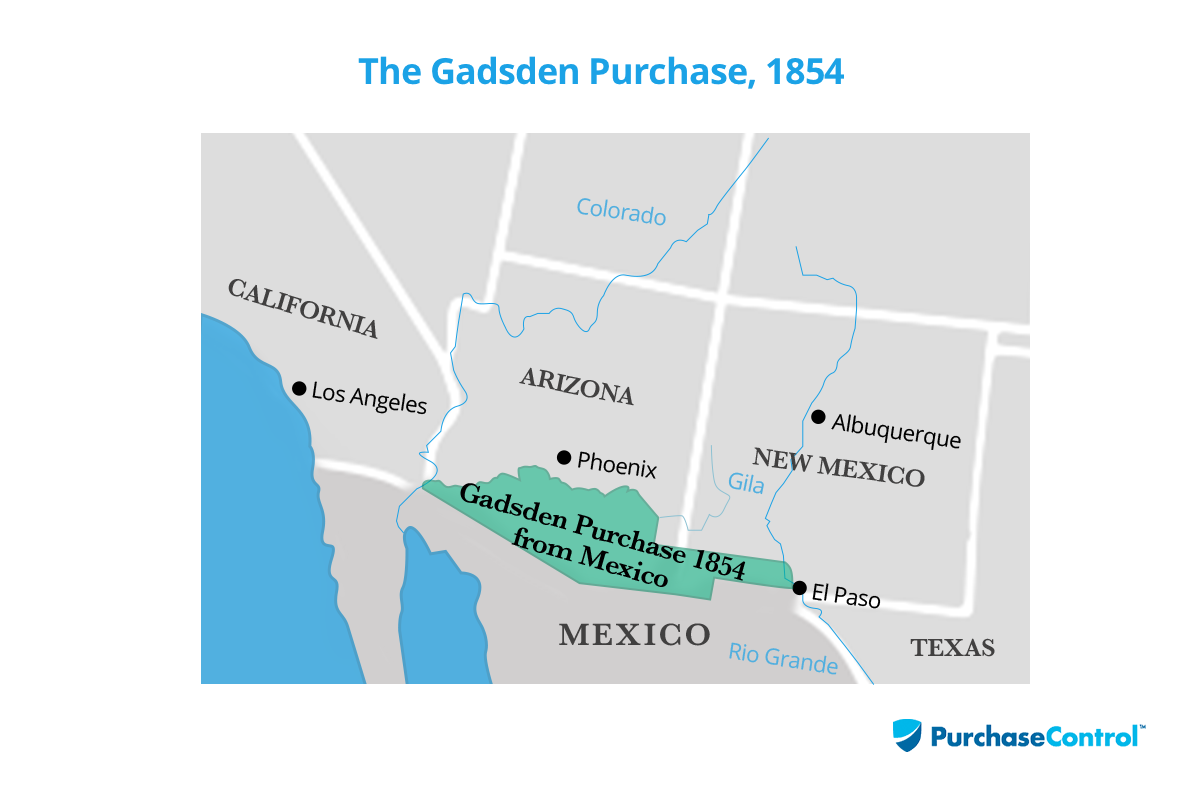Depending on their industry, procurement pros working in the modern marketplace usually don’t get a chance to alter the course of history—or international borders—when they’re practicing strategic spend.
But between 1853 and 1854, U.S. Minister to Mexico James Gadsden had the chance to do both when he negotiated the purchase that bears his name with then-President of Mexico, Antonio López de Santa Anna.
In a wild and wooly West where procurement was done with parchment and plume instead of purchasing software, the Gadsden Purchase marked a critical moment in North American history.
And like the Louisiana Purchase, the Gadsden Purchase (known in Mexico as Venta de La Mesilla, i.e., the Sale of Mesilla) had far-reaching impact beyond the exchange of money for land. It forever transformed relations, and borders, between the nations of Mexico and the United States.
Santa Anna was more amenable to negotiation than his predecessors, but extremely reluctant to cede any more Mexican territory than was necessary. However, like Napoleon during negotiations for the Louisiana Purchase half a century earlier, he had an army to feed and support.
The Final “Big Buy”
The growing, expansionist-minded United States acquired quite a bit of territory in the nineteenth century, and the Gadsden Purchase (also called the Gadsden Purchase Treaty) was the last of the “big buys.”
The Gadsden Purchase was initially earmarked to obtain southwest territory located “south of the Gila River and west of the Rio Grande.”
Stretching across the southern Arizona Territory and New Mexico Territory, covering 29,670 square miles (76,845 square kilometers, or roughly the size of the Czech Republic) and carrying a price tag of $10 million, the Gadsden Purchase was a fraction of the Louisiana Purchase in scale and price but occupied, and continues to occupy, a place of similar import in American history.

A present-day company with a big budget might drop $10 million on marketing efforts in a single quarter these days, but it’s important to remember that inflation is a harsh mistress.
Translated to 2019 dollars, the Gadsden Purchase cost the United States $304,871,429.
With that kind of buying power, you could:
- Buy more than a hundred 2MW windmills and take your house (and business, and town) off the grid.
- Snatch up the most expensive house in the United States (with enough change left to buy a luxury ranch for those weekend getaways).
- Add some digital pizzazz to your internal process improvement, like McDonald’s did in 2019 when it bought Dynamic Yield.
- Invest (naturally) in some land holdings of your own. The annual company picnic is a lot more fun on a well-stocked private island. You’d even have enough left over to cover airfare!
Peace, Progress, and a Few New Problems
While the Mexican-American War had come to an end with the signing of the Treaty of Guadalupe Hidalgo in 1848, mutual resentment and disagreement over claims to certain regions of the continent did not.
One of the most hotly contested areas was the Mesilla Valley. Mexico was reluctant to part with more territory after having to cede substantial portions of Northern Mexico in the Treaty of Guadalupe Hidalgo.
For its part, the United States was eager to connect its southern enterprises in the east with the distant Pacific coast in California, creating new and profitable opportunities for trade, and wanted to build a southern route across new territory—in the form of a transcontinental railroad line—for this purpose.
In addition to the question of Mesilla Valley’s ownership, the treaty between Mexico and the United States had created an additional issue and left unaddressed another:
- The Treaty of Guadalupe Hidalgo guaranteed protection for Mexican citizens from incursions into Mexican territory by raiding Native American tribes, to be provided by the United States military. After spending an estimated $12 million ($399 million in 2019 dollars) combating Comanche and Apache raids over five years following the treaty’s ratification, the United States was struggling to police the border with Mexico, and the Mexican government was frustrated with the lives, goods, and property lost to the raids.Mexico’s demands for reparations to compensate its citizens for the United States’ perceived failure fell on unreceptive ears.
- The United States also wanted, but failed to secure, right of passage through the Isthmus of Tehuantepec in the Treaty of Guadalupe Hidalgo. The 125-mile-wide land bridge provided the ideal location to connect the Gulf of Mexico to the Pacific Ocean, and as with the southern transcontinental railroad from the east to the Pacific coast, American businesses were keen to be involved in constructing a railroad that would forge this connection.
The United States government attempted to purchase the isthmus in 1847, but the area had already been granted to Don Jose de Garay, who had planned to build colonies for the United States on the isthmus. The interest from the government led to fears of colonial headaches like the ones Mexico had encountered with Texas, so then-Mexican President Juan Ceballos revoked de Garay’s grant and refused sale.
A New York businessman, Peter Hargous, purchased the rights to construct a connecting southern route on the isthmus in 1849 for $25,000 ($831,468 in 2019 dollars), but the lack of formal support from both nations rendered such rights questionable at best.
By 1853, Mexico was evicting American colonists from the Mesilla Valley.
No official response from the United States government followed, but then-Governor of New Mexico, William Lane, acted on his territory’s behalf and claimed the valley as part of New Mexico.
Mexican President Santa Anna sent troops to the valley in response, and United States President Franklin Pierce dispatched James Gadsden to bargain with Santa Anna and work toward peace and progress for both nations.
The Price of Peace and Passage
President Pierce sent Gadsden to Mexico City with three goals:
- Negotiate a border between Mexico and the United States that allowed access for a southern railroad route to the Pacific.
- Free the United States from its perceived financial responsibility to compensate Mexico for Native American incursions.
- Settle the various monetary claims and conflicts related to the Isthmus of Tehuantepec.
Santa Anna was more amenable to negotiation than his predecessors, but extremely reluctant to cede any more Mexican territory than was necessary.
However, like Napoleon during negotiations for the Louisiana Purchase half a century earlier, he had an army to feed and support.
In the end, Santa Anna signed the Gadsden treaty on December 30th, 1853, agreeing to sell 45,000 square miles (later adjusted by a prickly U.S. Senate to 29,670 square miles in a revised 1854 version of the treaty) for $15 million (adjusted to $10 million in the revision ratified by Congress) to the United States.
In addition, Mexico agreed to shoulder the financial burdens of claims related to the assorted deals and conflicts in the Isthmus of Tehuantepec. Sana Anna also voided America’s financial responsibility attacks across the Mexican border by Native Americans.
In the wake of the agreement, the Southern Pacific Railroad (only slightly delayed by America’s Civil War in the early 1860s) did manage to complete a railroad across the Gadsden Purchase, connecting El Paso, Texas, Yuma, Arizona, and Deming New Mexico with Los Angeles, California.
However, the deal was not a total success; even with the concessions from Mexico, simmering tensions between the two nations continued for decades after.
The deal did create the current southern border of the United States, bringing to a close America’s large-scale territorial acquisitions in the contiguous United States, and opening the Western U.S. to expansion and trade.
Big or Small, Every Purchase Matters
While your latest project may not bridge diplomatic conflict or sketch out new borders for your business, effective and strategic procurement is every bit as important to modern businesses as it was to the early United States government.
And even if your name’s not forever emblazoned in the annals of history, you can still emulate James Gadsden by using smart, strategic sourcing, strong negotiation, and the tech tools at your disposal to achieve your goals for quality, price, and value.




